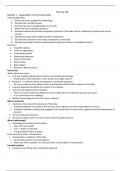Class notes
Modules 1-4 Lecture Notes for Midterm 1 of NURS 120
- Course
- (NURS120)
- Institution
- University Of Saskatchewan (USask )
Lecture notes for modules one and four of Nursing 120. This includes the skeletal system, tissues, organ systems, cell organization, and organization of the human body.
[Show more]



